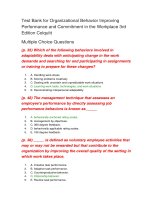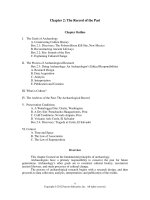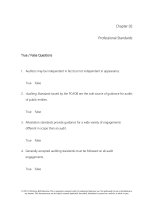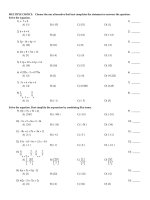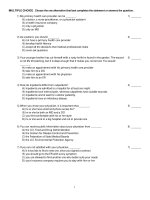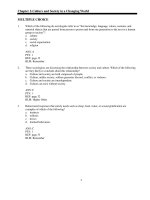Organizational behavior improving performance and commitment in the workplace 5th edition colquitt test bank
Bạn đang xem bản rút gọn của tài liệu. Xem và tải ngay bản đầy đủ của tài liệu tại đây (430.45 KB, 109 trang )
Chapter 02
Job Performance
True / False Questions
1. Evaluating an employee's performance based on results alone gives an accurate picture of
which employees are worth more to an organization.
True
False
2. Job performance is formally defined as the value of the set of employee behaviors that
contribute, either positively or negatively, to organizational goal accomplishment.
True
False
3. Task performance includes employee behaviors that are directly involved in the
transformation of organizational resources into the goods or services that the organization
produces.
True
False
4. Task performance is the set of explicit obligations that an employee must fulfill to receive
compensation and continued employment.
True
False
5. Routine task performance can involve employee responses to task demands that are novel,
unusual, or, at the very least, unpredictable.
True
False
2-1
Copyright © 2017 McGraw-Hill Education. All rights reserved. No reproduction or distribution without the prior written consent of
McGraw-Hill Education.
6. Adaptive task performance involves employee responses to task demands that are novel,
unusual, or, at the very least, unpredictable.
True
False
7. Employees' performance of routine task behaviors is becoming increasingly important as
globalization, technological, advances, and knowledge-based work increase the pace of
change in the workplace.
True
False
8. Creative task performance is the degree to which individuals develop ideas or physical
outcomes that are both novel and useful.
True
False
9. Creative task performance is a behavior that is only valuable in jobs such as artist and
inventor.
True
False
10. The first step in conducting a job analysis is to generate a list of all the activities involved in a
job.
True
False
11. The O*NET is an online government database that describes the results of task performance
behaviors that must be reported by firms to the government on an annual basis.
True
False
12. O*NET captures the "numerous small decisions" that separate the most effective
organizations from their competitors.
True
False
2-2
Copyright © 2017 McGraw-Hill Education. All rights reserved. No reproduction or distribution without the prior written consent of
McGraw-Hill Education.
13. Creative ideas that are not implemented do not count toward positive job performance.
True
False
14. Citizenship behavior is defined as voluntary employee activities that may or may not be
rewarded.
True
False
15. Courtesy refers to keeping coworkers informed about matters that are relevant to them.
True
False
16. Sportsmanship involves maintaining a good attitude with coworkers, even when they've done
something annoying or when the unit is going through tough times.
True
False
17. When employees work in small groups or teams, interpersonal citizenship behavior is not
important.
True
False
18. Organizational citizenship behaviors benefit the larger organization by supporting and
defending the company, working to improve its operations, and being especially loyal to it.
True
False
19. Boosterism involves speaking up and offering constructive suggestions for change.
True
False
20. Counterproductive behavior is defined as employee behaviors that unintentionally hinder
organizational goal accomplishment.
True
False
2-3
Copyright © 2017 McGraw-Hill Education. All rights reserved. No reproduction or distribution without the prior written consent of
McGraw-Hill Education.
21. Property deviance refers to behaviors that harm the organization's assets and possessions.
True
False
22. Wasting resources is the most common form of production deviance.
True
False
23. Substance abuse is a form of political deviance.
True
False
24. Political deviance refers to behaviors that intentionally harm the organization's assets and
possessions.
True
False
25. Gossiping is communication that is rude, impolite, discourteous, and lacking in good
manners.
True
False
26. Personal aggression is defined as hostile verbal and physical actions directed toward other
employees.
True
False
27. People who engage in one form of counterproductive behavior do not usually engage in other
forms.
True
False
28. Sometimes the best task performers also engage in counterproductive behavior.
True
False
2-4
Copyright © 2017 McGraw-Hill Education. All rights reserved. No reproduction or distribution without the prior written consent of
McGraw-Hill Education.
29. There is a positive correlation between task performance and counterproductive behavior.
True
False
30. In addition to being more cognitive, knowledge work tends to be more structured and static in
nature.
True
False
31. Service work involves direct verbal or physical interaction with customers.
True
False
32. Service work contexts place a greater premium on high levels of citizenship behavior and low
levels of counterproductive behavior.
True
False
33. The MBO approach involves collecting performance information not just from the supervisor
but from anyone else who might have firsthand knowledge about the employee's performance
behaviors.
True
False
34. BARS emphasizes the results of job performance as much as it does the performance
behaviors themselves.
True
False
35. Feedback from BARS can help an employee develop and improve over time.
True
False
36. Very few 360-degree feedback systems ask the employee to provide ratings of his/her own
performance.
True
False
2-5
Copyright © 2017 McGraw-Hill Education. All rights reserved. No reproduction or distribution without the prior written consent of
McGraw-Hill Education.
37. Despite its popularity, 360-degree feedback is not well suited for developing employee
talent.
True
False
38. In a 360-degree rating system, when participants believe the information will be used for
compensation, rather than for skill development, there is a very low level of bias.
True
False
39. A company that tells managers that only 10 percent of their subordinates can receive
excellent performance ratings and an additional 12 percent must receive unacceptable
rankings is using a percentage ranking system.
True
False
40. Forced ranking systems can force managers to give bad evaluations to good performers.
True
False
41. Social networking sites and their applications can be used to monitor employee
performance.
True
False
Multiple Choice Questions
2-6
Copyright © 2017 McGraw-Hill Education. All rights reserved. No reproduction or distribution without the prior written consent of
McGraw-Hill Education.
42. The value of the set of employee behaviors that contribute, either positively or negatively, to
organizational goal accomplishment is known as _____.
A. citizenship behavior
B. task orientation
C. job satisfaction
D. job performance
E. organizational commitment
43. _____ includes employee behaviors that are directly involved in the transformation of
organizational resources into the goods or services that the organization produces.
A. Task performance
B. Citizenship behavior
C. Counterproductive behavior
D. Job orientation
E. Organizational commitment
44. When an athletic director at State University evaluates how much time a coach spends with
the team, the coach's ethical impact on team member behaviors, and the clarity of the
coach's explanations of new plays, the manager is assessing the coach's ______.
A. job performance
B. team commitment
C. organizational commitment
D. productivity
E. leadership
2-7
Copyright © 2017 McGraw-Hill Education. All rights reserved. No reproduction or distribution without the prior written consent of
McGraw-Hill Education.
45. Dr. Hogan, Dean of the College of Business, evaluates the performance of Dr. Maskulka, a
faculty member in the college, by looking at student and peer evaluations of Dr. Maskulka's
teaching, the number and quality of her research publications, and her service to the
university, all of which are described in the job description of a faculty member's
responsibilities. She also pays attention to Dr. Maskulka's willingness to take on extra tasks
that are not required, such as recruiting new faculty members and contacting local
businesses to involve them with student project teams for her marketing class. She is
assessing the faculty member's:
A. task performance.
B. job performance.
C. citizenship behavior.
D. counterproductive behavior.
E. commitment.
46. The explicit obligations that an employee must fulfill to receive compensation and continued
employment are referred to as _____.
A. job orientation
B. citizenship behavior
C. organizational commitment
D. task performance
E. counterproductive behavior
47. Charles finds an advertisement for an accountant's position at a local office. The
advertisement mentions preparing, examining, and analyzing accounting records for accuracy
and completeness as job responsibilities of the position. This job description refers to:
A. comprehension skills.
B. task performance.
C. counterproductive behavior.
D. citizenship behaviors.
E. organizational commitment.
2-8
Copyright © 2017 McGraw-Hill Education. All rights reserved. No reproduction or distribution without the prior written consent of
McGraw-Hill Education.
48. _____ involves well-known responses to normal job demands that occur in a predictable way.
A. Job enhancement
B. Adaptive task performance
C. Counterproductive behavior
D. Routine task performance
E. Citizenship behavior
49. Paul, a ticket collector, performs his duty robotically every day. This refers to _____.
A. sportsmanship
B. adaptive task performance
C. routine task performance
D. counterproductive behavior
E. citizenship behavior
50. Sandy works in a factory where employees are expected to complete 14 widgets each hour.
The managers are very strict and frequently check to make sure employees are actually
completing at least this base number of widgets each hour. The employees are being
assessed on their ______.
A. routine task performance
B. pacing
C. interpretive task performance
D. work ability
E. creative task performance
2-9
Copyright © 2017 McGraw-Hill Education. All rights reserved. No reproduction or distribution without the prior written consent of
McGraw-Hill Education.
51. _____ involves employee responses to job demands that are novel, unusual, or unpredictable.
A. Job dissonance
B. Adaptive task performance
C. Counterproductive behavior
D. Routine task performance
E. Citizenship behavior
52. For a kindergarten teacher, assisting her students out of a smoke-filled elementary school is
an example of _____.
A. citizenship behavior
B. routine task performance
C. job dissonance
D. counterproductive behavior
E. adaptive task performance
53. Adaptability involves all of the following except:
A. handling work stress.
B. solving problems creatively.
C. handling emergencies.
D. performing daily routine work.
E. responding to unpredictable demands.
2-10
Copyright © 2017 McGraw-Hill Education. All rights reserved. No reproduction or distribution without the prior written consent of
McGraw-Hill Education.
54. Which of the following behaviors involved in adaptability deals with anticipating change in the
work demands and searching for and participating in assignments or training to prepare for
these changes?
A. Handling work stress
B. Solving problems creatively
C. Dealing with uncertain and unpredictable work situations
D. Learning work tasks, technologies, and work situations
E. Demonstrating interpersonal adaptability
55. Riya has become famous creating new styles in women's formal wear. Her assistants copy
the patterns she creates, cut pieces of cloth, and sew them into garments. The work done by
Riya is a type of _____ whereas the work done by her assistants is a type of _____.
A. routine task performance; creative task performance
B. creative task performance; counterproductive behavior
C. citizenship behavior; counterproductive behavior
D. counterproductive behavior; creative task performance
E. creative task performance; routine task performance
56. Managers know what behaviors to emphasize in training programs and to assess when doing
performance evaluations by referring to a(n) ______.
A. job analysis
B. performance contract
C. cultural evaluation
D. organizational chart
E. structural analysis
2-11
Copyright © 2017 McGraw-Hill Education. All rights reserved. No reproduction or distribution without the prior written consent of
McGraw-Hill Education.
57. Which of the following statements concerning job analysis is incorrect?
A. The first step in job analysis is to generate a list of all job activities.
B. A subject matter expert is consulted regarding the frequency and importance of all job
activities.
C. A list of all job activities is generated using various sources of data such as surveys,
employee interviews, and observations.
D. Activities with the lowest ratings are used to define job responsibilities.
E. Job analysis is used by many organizations to identify task performance behaviors.
58. The electronic database used to identify the set of behaviors needed to define task
performance is known as the:
A. behaviorally anchored ratings scale network.
B. employment analysis network.
C. occupational information network.
D. task performance analysis network.
E. job responsibilities network.
59. Which of the following statements about the O*NET is false?
A. It captures the "numerous small decisions" that separate the most effective organizations
from their competitors.
B. It is an online database.
C. It is involved in figuring out the important tasks for a given job.
D. It includes the characteristics of most jobs in terms of tasks.
E. It includes the required knowledge, skills, and abilities to perform a task.
2-12
Copyright © 2017 McGraw-Hill Education. All rights reserved. No reproduction or distribution without the prior written consent of
McGraw-Hill Education.
60. _____ is defined as voluntary employee activities that may or may not be rewarded but that
contribute to the organization by improving the overall quality of the setting in which work
takes place.
A. Creative task performance
B. Adaptive task performance
C. Counterproductive behavior
D. Citizenship behavior
E. Routine task performance
61. Citizenship behaviors can be divided into the two main categories of:
A. intrapersonal and organizational.
B. interpersonal and intrapersonal.
C. organizational and political.
D. interpersonal and political.
E. interpersonal and organizational.
62. Which of the following behaviors benefits coworkers and colleagues and involves assisting,
supporting, and developing other organizational members in a way that goes beyond normal
job expectations?
A. Intrapersonal citizenship behavior
B. Interpersonal citizenship behavior
C. Organizational citizenship behavior
D. Production citizenship behavior
E. Political citizenship behavior
2-13
Copyright © 2017 McGraw-Hill Education. All rights reserved. No reproduction or distribution without the prior written consent of
McGraw-Hill Education.
63. Interpersonal citizenship behaviors consist of all the following except:
A. helping.
B. courtesy.
C. sportsmanship.
D. boosterism.
E. respect for others.
64. Interpersonal citizenship behavior includes:
A. voice.
B. civic virtue.
C. sportsmanship.
D. boosterism.
E. secrecy.
65. Don always maintains a good attitude with coworkers even when the department goes
through tough times. Don's behavior is an example of:
A. helping.
B. courtesy.
C. sportsmanship.
D. civic virtue.
E. boosterism.
2-14
Copyright © 2017 McGraw-Hill Education. All rights reserved. No reproduction or distribution without the prior written consent of
McGraw-Hill Education.
66. Which of the following is false about interpersonal citizenship behavior?
A. A team whose members have good interpersonal citizenship behavior is likely to have a
positive team atmosphere.
B. Interpersonal citizenship behavior is most important when employees work in small
groups.
C. Interpersonal citizenship behavior is most important when employees work in large groups.
D. Behaviors that commonly fall under the "teamwork" heading are examples of interpersonal
citizenship behavior.
E. Team members with good interpersonal citizenship behavior tend to work toward achieving
common goals.
67. Which of the following is an organizational citizenship behavior?
A. Civic virtue
B. Courtesy
C. Representing self-interests in a positive way to the public
D. Sportsmanship
E. Behaviors that benefit employees with excess workloads
68. Some people react to bad rules or policies by constructively trying to change them, instead of
passively complaining about them. This positive characteristic refers to:
A. helping.
B. sportsmanship.
C. voice.
D. civic virtue.
E. boosterism.
2-15
Copyright © 2017 McGraw-Hill Education. All rights reserved. No reproduction or distribution without the prior written consent of
McGraw-Hill Education.
69. Natalie, Rose, and Charles are three dental hygienists who work for Dr. Doris at Healthy
White. All three hygienists perform almost the same tasks every day. On average, they see 12
people every day for regular teeth cleaning, which involves cleaning, flossing, rinsing, and a
normal checkup. Dr. Doris, on the other hand, has quite an unpredictable job. She has to
respond to all types of dental emergencies, including situations involving surgery. All three
hygienists always try to help each other out, have a very good attitude toward each other, and
keep each other informed about matters that are relevant to them and to Dr. Doris. Natalie
specifically takes on the role of attending all community-related voluntary meetings and
functions where Healthy White may have a stake or is asked to be present. She makes sure
that she is up to date with all dental regulations and business-related news that may have an
impact on Healthy White. Rose and Charles, on the other hand, can be described as the
unofficial publicists of Healthy White. They always represent the clinic in a very positive way
away from work. Dr. Doris couldn't be happier to have such wonderful people working with
her.
Natalie, Rose, and Charles contribute most directly to the business goals of the Healthy
White clinic through their:
A. creative task performance and interpersonal citizenship behaviors.
B. routine task performance and organizational and interpersonal citizenship behaviors.
C. interpersonal task performance and counterproductive behaviors.
D. intrapersonal task performance and intrapersonal citizenship behaviors.
E. adaptive task performance and creative citizenship behaviors.
2-16
Copyright © 2017 McGraw-Hill Education. All rights reserved. No reproduction or distribution without the prior written consent of
McGraw-Hill Education.
70. Natalie, Rose, and Charles are three dental hygienists who work for Dr. Doris at Healthy
White. All three hygienists perform almost the same tasks every day. On average, they see 12
people every day for regular teeth cleaning, which involves cleaning, flossing, rinsing, and a
normal checkup. Dr. Doris, on the other hand, has quite an unpredictable job. She has to
respond to all types of dental emergencies, including situations involving surgery. All three
hygienists always try to help each other out, have a very good attitude toward each other, and
keep each other informed about matters that are relevant to them and to Dr. Doris. Natalie
specifically takes on the role of attending all community-related voluntary meetings and
functions where Healthy White may have a stake or is asked to be present. She makes sure
that she is up to date with all dental regulations and business-related news that may have an
impact on Healthy White. Rose and Charles, on the other hand, can be described as the
unofficial publicists of Healthy White. They always represent the clinic in a very positive way
away from work. Dr. Doris couldn't be happier to have such wonderful people working with
her.
Dr. Doris contributes most directly to the business goals of the Healthy White through:
A. creative task performance.
B. routine task performance.
C. interpersonal task performance.
D. intrapersonal task performance.
E. adaptive task performance.
2-17
Copyright © 2017 McGraw-Hill Education. All rights reserved. No reproduction or distribution without the prior written consent of
McGraw-Hill Education.
71. Natalie, Rose, and Charles are three dental hygienists who work for Dr. Doris at Healthy
White. All three hygienists perform almost the same tasks every day. On average, they see 12
people every day for regular teeth cleaning, which involves cleaning, flossing, rinsing, and a
normal checkup. Dr. Doris, on the other hand, has quite an unpredictable job. She has to
respond to all types of dental emergencies, including situations involving surgery. All three
hygienists always try to help each other out, have a very good attitude toward each other, and
keep each other informed about matters that are relevant to them and to Dr. Doris. Natalie
specifically takes on the role of attending all community-related voluntary meetings and
functions where Healthy White may have a stake or is asked to be present. She makes sure
that she is up to date with all dental regulations and business-related news that may have an
impact on Healthy White. Rose and Charles, on the other hand, can be described as the
unofficial publicists of Healthy White. They always represent the clinic in a very positive way
away from work. Dr. Doris couldn't be happier to have such wonderful people working with
her.
The three hygienists interact with one another in a manner that reflects high levels of _____.
A. boosterism
B. interpersonal citizenship behavior
C. routine task performance
D. adaptive task performance
E. centralized behavior
2-18
Copyright © 2017 McGraw-Hill Education. All rights reserved. No reproduction or distribution without the prior written consent of
McGraw-Hill Education.
72. Natalie, Rose, and Charles are three dental hygienists who work for Dr. Doris at Healthy
White. All three hygienists perform almost the same tasks every day. On average, they see 12
people every day for regular teeth cleaning, which involves cleaning, flossing, rinsing, and a
normal checkup. Dr. Doris, on the other hand, has quite an unpredictable job. She has to
respond to all types of dental emergencies, including situations involving surgery. All three
hygienists always try to help each other out, have a very good attitude toward each other, and
keep each other informed about matters that are relevant to them and to Dr. Doris. Natalie
specifically takes on the role of attending all community-related voluntary meetings and
functions where Healthy White may have a stake or is asked to be present. She makes sure
that she is up to date with all dental regulations and business-related news that may have an
impact on Healthy White. Rose and Charles, on the other hand, can be described as the
unofficial publicists of Healthy White. They always represent the clinic in a very positive way
away from work. Dr. Doris couldn't be happier to have such wonderful people working with
her.
Natalie's acts of attending events on behalf of Healthy White and keeping abreast of dental
regulations and business related news during her personal time refer to:
A. counterproductive behavior.
B. boosterism.
C. civic virtue.
D. sportsmanship.
E. voice.
2-19
Copyright © 2017 McGraw-Hill Education. All rights reserved. No reproduction or distribution without the prior written consent of
McGraw-Hill Education.
73. Natalie, Rose, and Charles are three dental hygienists who work for Dr. Doris at Healthy
White. All three hygienists perform almost the same tasks every day. On average, they see 12
people every day for regular teeth cleaning, which involves cleaning, flossing, rinsing, and a
normal checkup. Dr. Doris, on the other hand, has quite an unpredictable job. She has to
respond to all types of dental emergencies, including situations involving surgery. All three
hygienists always try to help each other out, have a very good attitude toward each other, and
keep each other informed about matters that are relevant to them and to Dr. Doris. Natalie
specifically takes on the role of attending all community-related voluntary meetings and
functions where Healthy White may have a stake or is asked to be present. She makes sure
that she is up to date with all dental regulations and business-related news that may have an
impact on Healthy White. Rose and Charles, on the other hand, can be described as the
unofficial publicists of Healthy White. They always represent the clinic in a very positive way
away from work. Dr. Doris couldn't be happier to have such wonderful people working with
her.
Which of the following citizenship behaviors does Charles exhibit?
A. Voice
B. Feminism
C. Civic virtue
D. Boosterism
E. Political deviance
74. Delux Services was celebrating the 20th anniversary of its operations in more than 17
countries. Linda, a junior assistant in the Human Resources department, was not interested
in attending this celebratory event. The senior HR managers overheard Linda asking her
friends the reason for this party. Back at the office, after a review, it was found that Linda
never attended any of the meetings with the local business heads. Her lack of interest and
knowledge about the company would make her someone who displays _____.
A. high self-esteem
B. low civic virtue
C. "A" player characteristics
D. low self-worth
E. positive boosterism
2-20
Copyright © 2017 McGraw-Hill Education. All rights reserved. No reproduction or distribution without the prior written consent of
McGraw-Hill Education.
75. James is a junior level manager with the Palm Green Hotels. He is also a freelance journalist
for a local travel magazine. James keeps himself updated with news about his company and
always features the hotel in his weekly columns. He promotes his hotel to such an extent that
the number of visitors to the hotel has considerably increased. Which of the following
characteristics does James portray?
A. Edginess
B. Political deviance
C. Sportsmanship
D. Civic virtue
E. Boosterism
76. Employee behaviors that intentionally hinder organizational goal accomplishment are referred
to as:
A. mistaken errors.
B. omissions.
C. erroneous identities.
D. counterproductive behaviors.
E. counteractive mistakes.
77. Which of the following is a type of serious interpersonal counterproductive behavior?
A. Sabotage
B. Harassment
C. Incivility
D. Gossiping
E. Wasting resources
2-21
Copyright © 2017 McGraw-Hill Education. All rights reserved. No reproduction or distribution without the prior written consent of
McGraw-Hill Education.
78. Which of the following is a minor organizational counterproductive behavior?
A. Sabotage
B. Harassment
C. Incivility
D. Gossiping
E. Wasting resources
79. Which of the following is a serious organizational counterproductive behavior?
A. Incivility
B. Wasting resources
C. Gossiping
D. Sabotage
E. Substance abuse
80. Which of the following behaviors is a type of minor interpersonal counterproductive
behavior?
A. Sabotage
B. Harassment
C. Incivility
D. Substance abuse
E. Theft
2-22
Copyright © 2017 McGraw-Hill Education. All rights reserved. No reproduction or distribution without the prior written consent of
McGraw-Hill Education.
81. Terry works doing oil changes and is sick and tired of rude customers. Terry decides to
purposely use the wrong type of oil for the next rude customer knowing that it will harm the
customer's engine in the long run but won't be traceable or noticed immediately. If Terry does
this, his behavior would be a form of ______.
A. counterproductive behavior
B. citizenship behavior
C. creative property deviance
D. collateral theft
E. production deviance
82. Behaviors that intentionally harm the organization's assets and possessions are referred to
as:
A. production deviance.
B. political deviance.
C. property deviance.
D. personal aggression.
E. organizational aggression.
83. All of the following are forms of counterproductive behaviors except:
A. political deviance.
B. personal aggression.
C. property deviance.
D. production deviance.
E. conflict management.
2-23
Copyright © 2017 McGraw-Hill Education. All rights reserved. No reproduction or distribution without the prior written consent of
McGraw-Hill Education.
84. Which of the following behaviors is a type of production deviance?
A. Wasting resources and substance abuse
B. Sabotage and theft
C. Gossiping and incivility
D. Harassment and abuse
E. Interpersonal and organizational behaviors
85. Property deviance includes _____.
A. interpersonal and organizational behaviors
B. sabotage and theft
C. gossiping and incivility
D. harassment and abuse
E. wasting resources and substance abuse
86. Behaviors that intentionally disadvantage other individuals rather than the larger organization
are referred to as _____.
A. property deviance
B. organizational aggression
C. wasting resources
D. personal aggression
E. political deviance
87. Which of the following behaviors are forms of production deviance?
A. Wasting resources and substance abuse
B. Sabotage and theft
C. Gossiping and incivility
D. Harassment and abuse
E. Interpersonal and organizational behaviors
2-24
Copyright © 2017 McGraw-Hill Education. All rights reserved. No reproduction or distribution without the prior written consent of
McGraw-Hill Education.
88. Behaviors that focus specifically on reducing the efficiency of work output are known as
_____.
A. political deviance
B. property deviance
C. personal aggression
D. political aggression
E. production deviance
89. _____ is the most common form of production deviance.
A. Theft
B. Incivility
C. Wasting resources
D. Sabotage
E. Harassment
90. _____ represents communication that is rude, impolite, discourteous, and lacking in good
manners.
A. Abuse
B. Incivility
C. Harassment
D. Property deviance
E. Gossiping
2-25
Copyright © 2017 McGraw-Hill Education. All rights reserved. No reproduction or distribution without the prior written consent of
McGraw-Hill Education.


